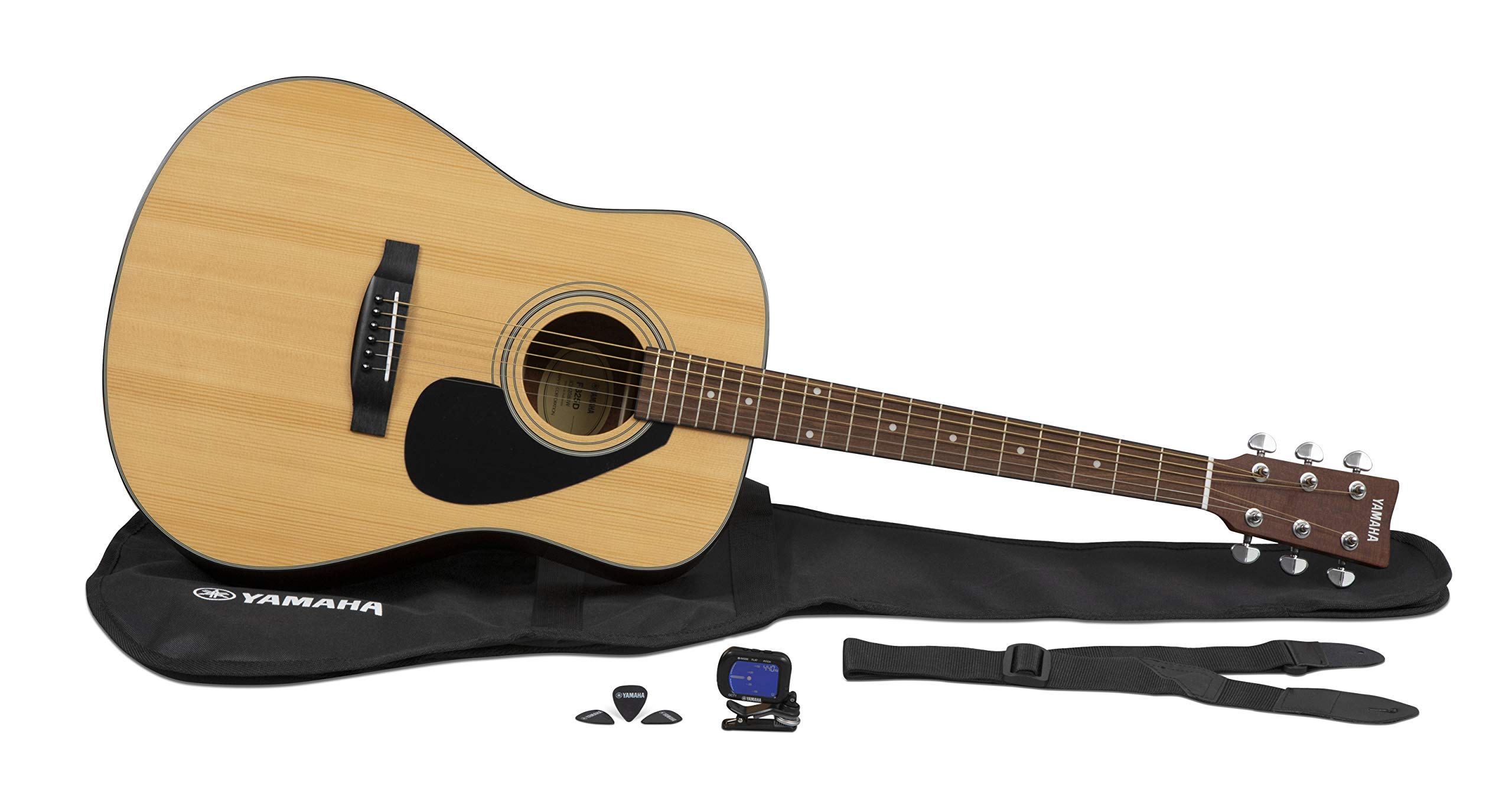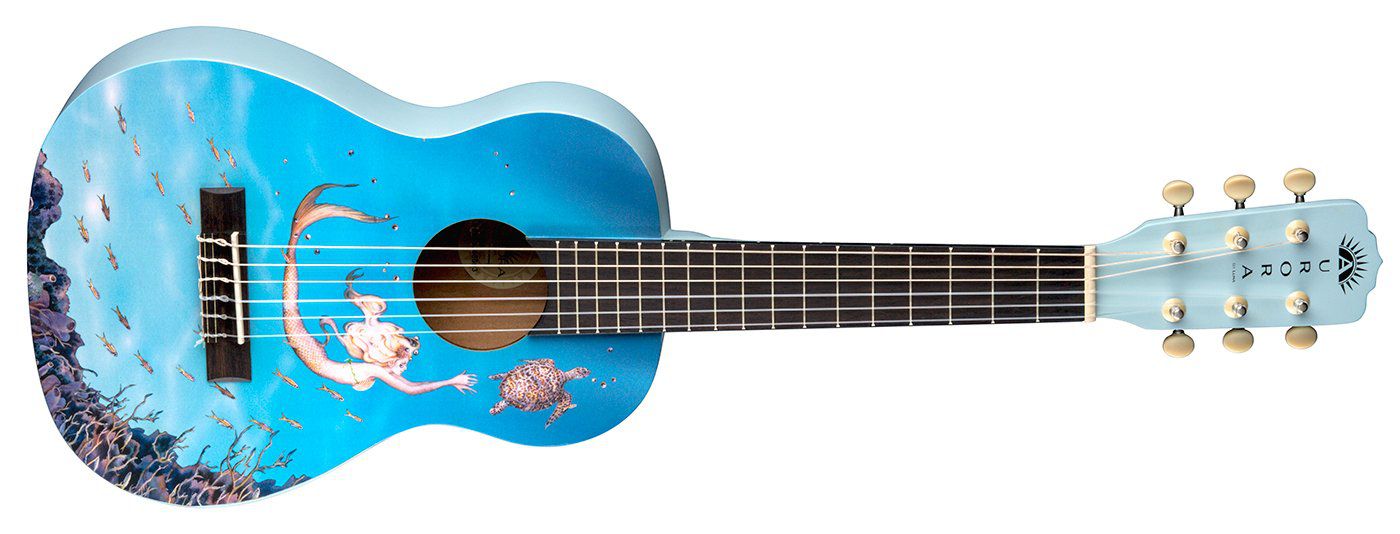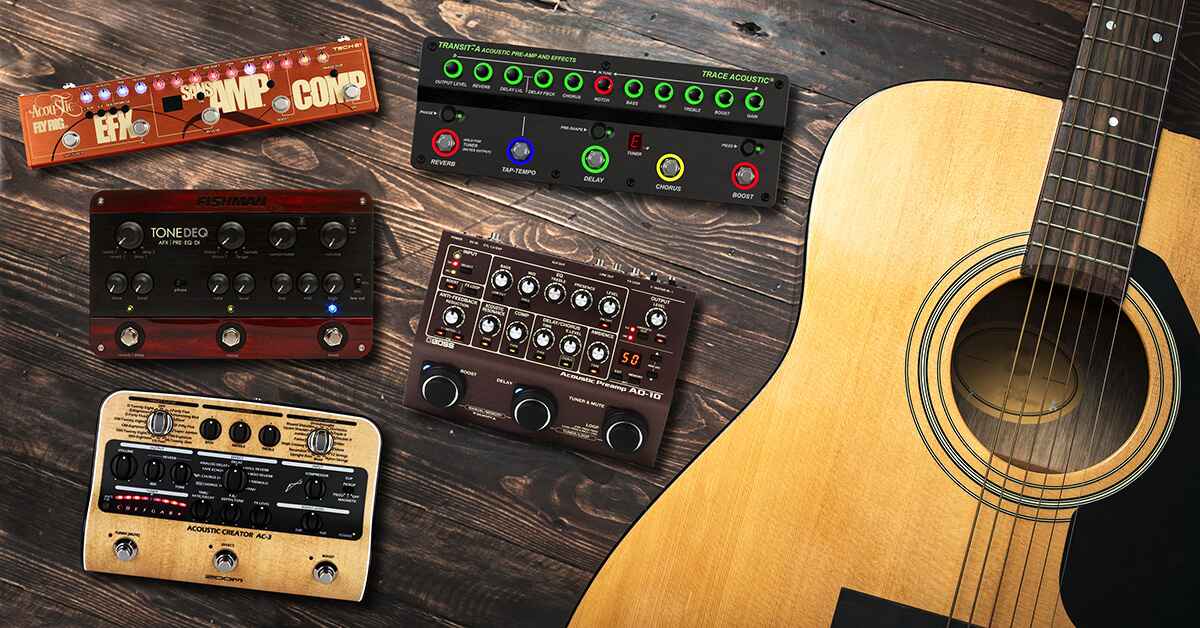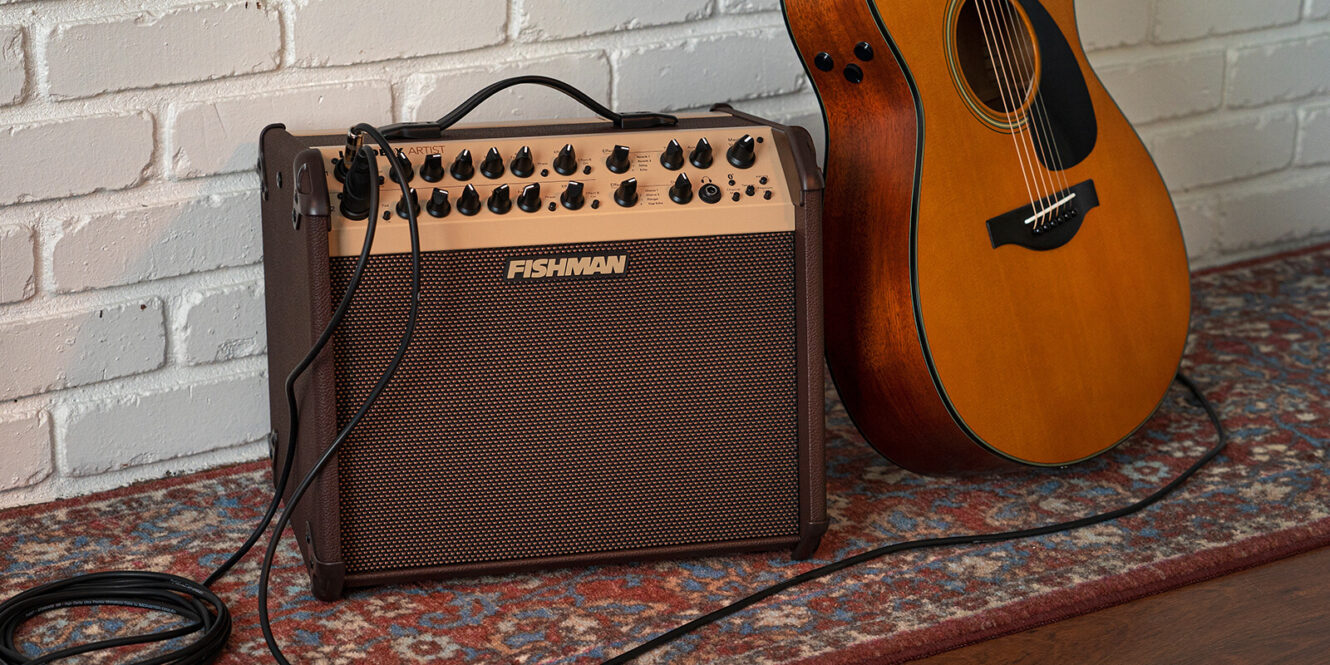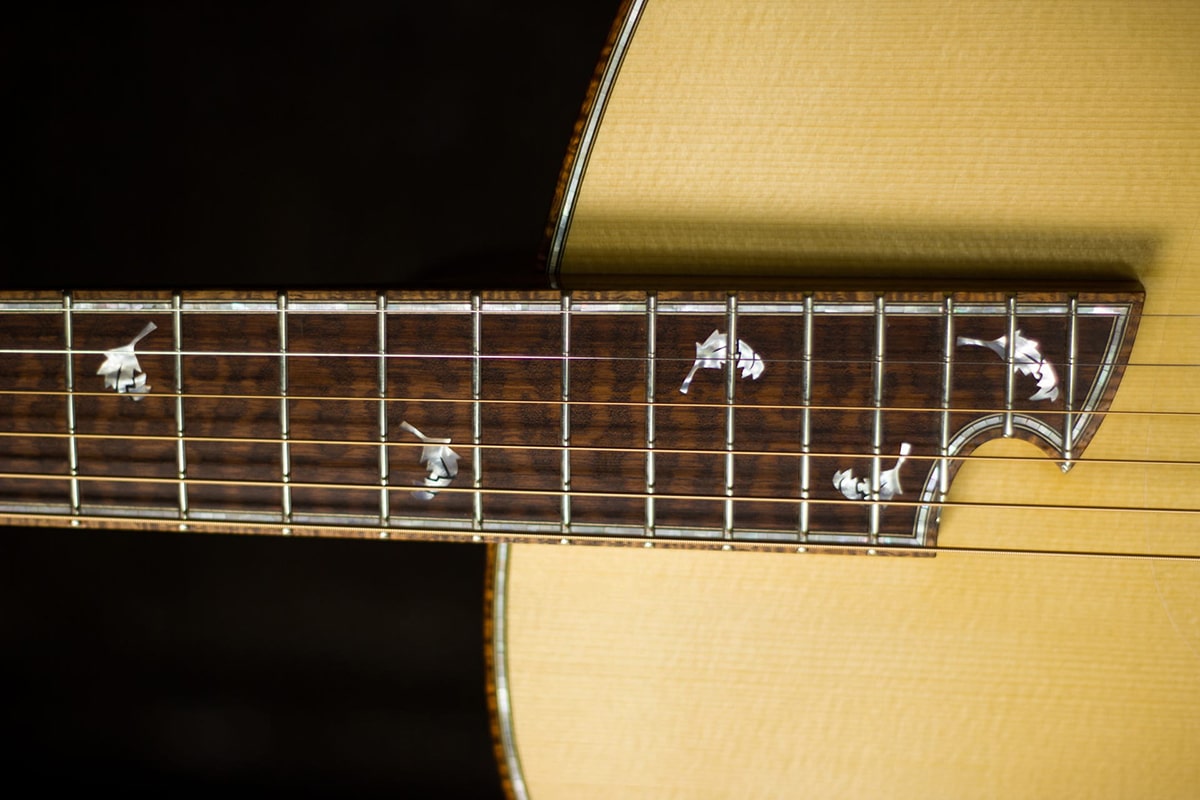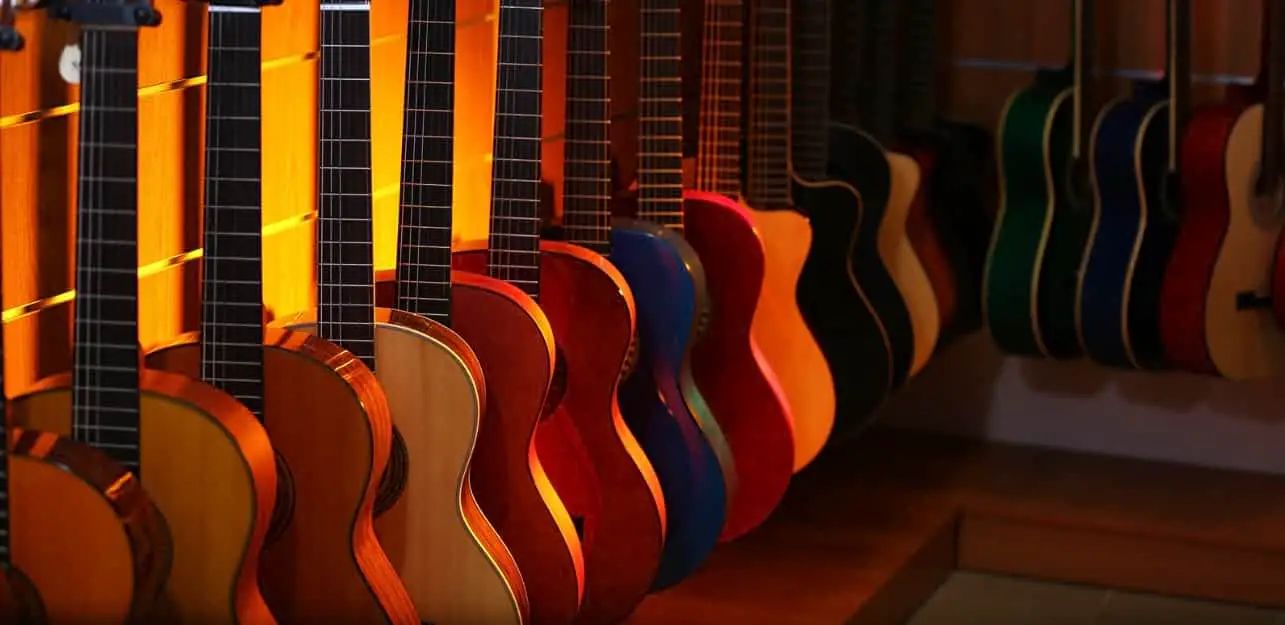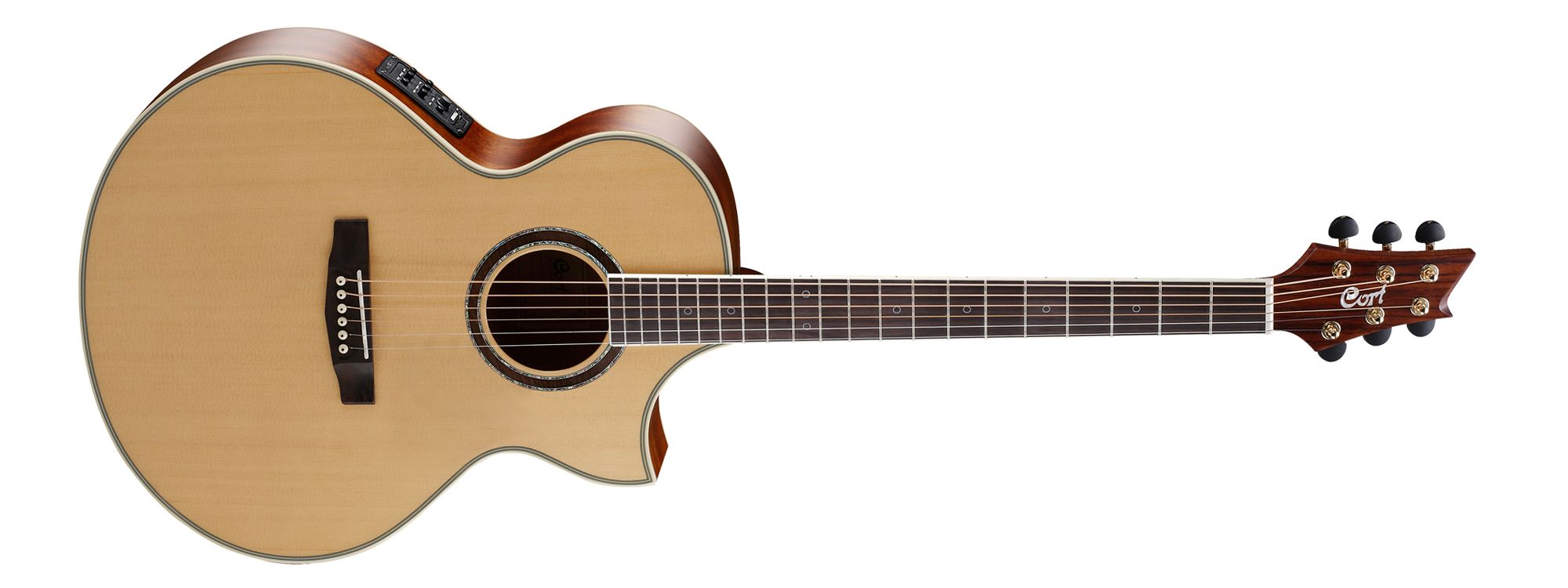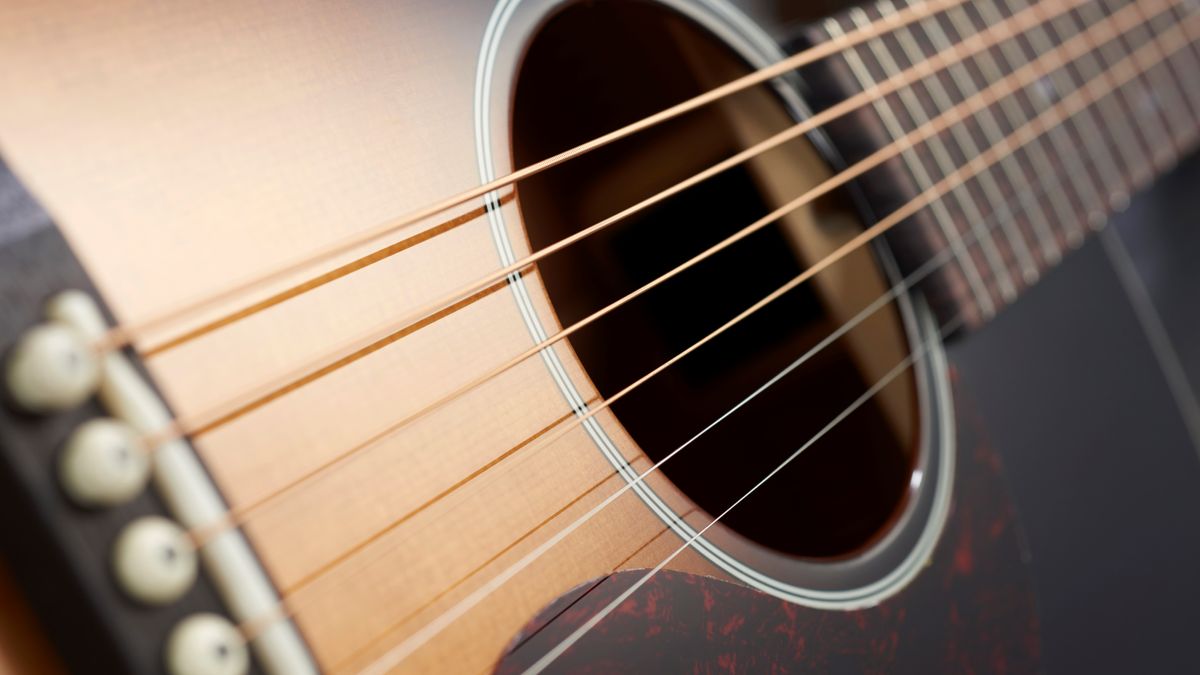Introduction
When it comes to acoustic guitars, size matters. The size of an acoustic guitar can greatly impact its sound, playability, and overall comfort. If you’re a guitarist or someone considering picking up this instrument, understanding the different sizes available is crucial in finding the right fit for you.
Acoustic guitars come in various sizes, from small travel guitars to larger concert-sized instruments. Each size offers unique characteristics that cater to different playing styles, preferences, and needs. By diving into the world of acoustic guitar sizes, you can make an informed decision and find a guitar that suits your playing style and musical goals.
Choosing the right size is essential for ensuring optimal comfort while playing. A guitar that feels too large or too small can hinder your playing experience and lead to physical strain. Additionally, the size of the guitar directly affects the sound it produces. Smaller guitars may have a brighter tone and be more suited for fingerpicking, while larger guitars may offer a deeper, more resonant sound.
Throughout this article, we’ll explore the different sizes of acoustic guitars, ranging from the popular dreadnought to more compact options like the parlor and travel sizes. We’ll look at the factors that influence the size choice, such as comfort, sound projection, and portability. By the end, you’ll have a better understanding of how guitar size can impact your playing experience and be equipped to select the right acoustic guitar for you.
Size Factors for Acoustic Guitars
When it comes to acoustic guitars, several factors determine their size. Understanding these factors can help you make an informed decision when choosing the right guitar size for your needs. Let’s explore the primary elements that influence the size of an acoustic guitar:
1. Body Size: The body size of an acoustic guitar refers to the dimensions and shape of the guitar’s body. It is one of the most significant factors that determine the overall size of the instrument. Acoustic guitars come in various body sizes, each offering different tonal characteristics and playability.
2. Scale Length: The scale length of a guitar is the distance between the nut and the saddle. It influences the string tension, playability, and overall feel of the instrument. Guitars with a longer scale length tend to have more pronounced string tension, while guitars with a shorter scale length often feel more comfortable to play.
3. Neck Profile: The neck profile refers to the shape and thickness of the guitar’s neck. It can significantly impact the playing experience, especially for those with smaller or larger hands. Different neck profiles cater to various playing styles and hand sizes, ensuring a comfortable grip and ease of playability.
4. Body Depth: The body depth of an acoustic guitar refers to the distance from the front of the guitar to the back. Deeper bodies tend to offer a more significant sound projection and resonance. However, they can also make the guitar feel bulkier and less comfortable to hold for some players.
5. Bout Width: The bout width refers to the width of the guitar’s waist or “middle” section. This measurement can impact the ergonomics and playing comfort. Narrower bouts may offer a more comfortable playing experience, especially for those with smaller body frames or shorter arms.
6. Top Bracing: The bracing pattern on the guitar’s top (soundboard) plays a crucial role in tonal projection and stability. Different bracing patterns affect the responsiveness, sustain, and volume of the instrument.
Considering these factors can help you choose an acoustic guitar size that aligns with your playing style, preferences, and physical attributes. By understanding the nuances of different size factors, you can find a guitar that feels comfortable to play and produces the desired sound.
Body Size Options
The body size of an acoustic guitar is one of the key considerations when choosing the right instrument. Different body sizes offer unique tonal characteristics, playing experiences, and suitability for specific musical styles. Let’s explore some of the most common acoustic guitar body sizes:
- Dreadnought: The dreadnought is one of the most popular and recognizable body sizes. It features a large body with a wide waist, providing a rich and powerful sound. Dreadnoughts are well-suited for strumming and flatpicking, making them ideal for genres like folk, country, and rock.
- Concert: Concert guitars, also known as “auditorium” or “folk” guitars, have a slightly smaller body than dreadnoughts. They offer a balanced tone, good projection, and are comfortable to hold. Concert guitars are versatile and suitable for various playing styles, including fingerstyle and light strumming.
- Grand Auditorium: Grand Auditorium guitars are a popular choice among acoustic guitarists. They strike a balance between the dreadnought and concert sizes, offering versatility in terms of sound and playability. The body shape is slightly curvier, providing a comfortable playing experience, and the sound is well-balanced with good projection.
- Orchestra: Orchestra-size guitars, sometimes referred to as “000” or “OM” guitars, have a smaller body compared to dreadnoughts. They offer a clear and focused tone, making them suitable for fingerpicking, blues, and light strumming. Orchestra-size guitars are comfortable to hold and have good note definition.
- Parlor: Parlor guitars are small-bodied instruments that were popular in the late 19th and early 20th centuries. They offer a unique vintage sound, characterized by warmth and intimacy. Parlor guitars are ideal for fingerpicking and blues, and their compact size makes them comfortable to play.
- Travel Size: Travel-size guitars are specifically designed for portability and convenience. They have a compact body size, making them easy to carry while traveling. While their sound may not be as loud or resonant as larger guitars, they provide a great option for practicing, songwriting, or playing on the go.
These are just a few examples of the body sizes available in the acoustic guitar world. Each size offers unique characteristics that cater to different playing styles, sound preferences, and physical comfort. When choosing a guitar, consider your playing style, the genres you enjoy, and the sound you want to achieve to narrow down your options and find the perfect fit.
Dreadnought
The dreadnought is a popular and iconic body size in the world of acoustic guitars. It was first introduced by the C.F. Martin & Co. company in the early 20th century and has since become a staple in the industry. The dreadnought body shape is known for its large size, broad shoulders, and wide waist, which gives it a bold and powerful sound.
One of the primary characteristics of the dreadnought is its ability to produce a loud and booming tone. The larger body size, combined with a deep body depth, enhances the guitar’s resonance and projection. This makes dreadnoughts ideal for strumming and flatpicking, as they can fill a room with rich, full-bodied sound.
While the dreadnought is often associated with genres like folk, country, and rock, its versatility shouldn’t be overlooked. Many guitarists appreciate the balanced tonal response and strong lower end that dreadnoughts deliver. They can also handle vigorous strumming without losing clarity or becoming muddy.
In addition to their powerful sound, dreadnought guitars are known for their robust construction. The larger body provides more internal air volume, resulting in increased resonance and sustain. Furthermore, the wide waist and spacious lower bout offer a comfortable playing experience, allowing players to grip the guitar with ease.
It’s worth noting that due to their size, dreadnought guitars may not be the most comfortable choice for all players. Those with smaller body frames or shorter arms might find it more challenging to reach around the larger body. However, many manufacturers now offer slimmed-down versions or models with cutaways to accommodate different player preferences.
Overall, the dreadnought body size remains a popular choice among guitarists across various genres. Its powerful and booming sound, coupled with sturdy construction, make it a reliable and versatile instrument. Whether you’re strumming chords, flatpicking melodies, or seeking a guitar that can project in live performances, the dreadnought is a go-to option that delivers a commanding presence and exceptional sound quality.
Concert
The concert guitar, also known as the auditorium or folk guitar, is a popular and versatile body size in the realm of acoustic guitars. With a slightly smaller body compared to the dreadnought, the concert size offers a unique balance of comfort, playability, and a well-rounded tone.
The concert guitar is known for its versatility, making it suitable for a wide range of playing styles and musical genres. Whether you’re strumming chords, playing fingerstyle, or picking intricate melodies, the concert size provides a balanced sound with good note definition.
One of the key advantages of the concert size is its comfortable playing experience. The smaller body size allows for easier reach across the fretboard, making it user-friendly for players with smaller hands or those who prefer a more compact instrument. The rounded waist and narrower bout width contribute to an ergonomic design that enhances playability.
In terms of sound, concert guitars offer a balanced and versatile tone. They tend to have a pronounced midrange with good clarity and note separation. This makes them ideal for both strumming and fingerpicking, as the individual notes stand out while still blending well together. The concert size strikes a good balance between volume and projection, making it suitable for both intimate settings and small gatherings.
Additionally, concert guitars are often favored by singer-songwriters due to their ability to accompany vocals while providing a pleasant tonal balance. Their versatility makes them an excellent choice for various musical genres, including folk, blues, pop, and more.
Another advantage of the concert size is its portability. While still larger than travel-size or parlor guitars, the concert size is compact enough to be easily transported. This makes it a popular choice for gigging musicians, as it strikes a balance between comfortable playing and the ability to be taken on the road.
Overall, the concert guitar offers a comfortable playing experience, versatile tonal capabilities, and easy portability. Whether you’re a beginner or an experienced guitarist, the concert size provides a well-rounded option that meets the needs of many players. Its balanced sound, comfortable design, and flexibility make it a go-to choice for those seeking an all-around acoustic guitar.
Grand Auditorium
The grand auditorium is a popular body size that strikes a balance between the larger dreadnought and the smaller concert guitar. It offers a versatile and well-rounded sound, making it a go-to choice for many acoustic guitarists.
One of the defining features of the grand auditorium is its slightly curvier body shape. This, combined with a narrower waist compared to a dreadnought, provides a comfortable playing experience. The guitar sits nicely on the lap, and the lower bout contours hug the body, reducing the strain on the player’s arm.
The grand auditorium body size offers a well-balanced tonal response. It typically delivers a clear and articulate sound with a pronounced midrange and a tighter bass response compared to a dreadnought. The treble notes are crisp and defined, allowing for excellent note separation and versatility across various playing styles.
In terms of versatility, the grand auditorium shines. It is well-suited for both strumming and fingerpicking, making it a go-to choice for many acoustic guitarists. Whether you prefer to strum chords with a full-bodied sound or intricate fingerstyle patterns with crisp note definition, the grand auditorium can handle it all.
Furthermore, the grand auditorium size offers excellent dynamics and responsiveness. It responds well to changes in playing style and technique, allowing for nuanced and expressive performances. Whether you play softly or with intensity, the guitar responds accordingly, delivering a dynamic range that captivates listeners.
The grand auditorium’s versatility makes it suitable for a wide range of musical genres, from folk and blues to pop and rock. Whether you’re performing on stage, recording in the studio, or simply playing for your own enjoyment, the grand auditorium can adapt to your playing needs.
Lastly, the grand auditorium size provides a great compromise for those who appreciate the tonal characteristics of both larger and smaller body sizes. Its balanced sound, comfortable playing experience, and versatility make it a popular choice for many guitarists seeking a reliable and adaptable instrument.
Overall, the grand auditorium body size offers a comfortable playing experience, a well-balanced sound, and versatility that meets the needs of many acoustic guitar players. Its ergonomic design, tonal capabilities, and responsiveness make it an excellent choice for both beginners and experienced musicians looking for a dependable instrument for various musical applications.
Orchestra
The orchestra-size guitar, also known as the “000” or “OM” guitar, is a smaller-bodied acoustic guitar that offers a unique and distinctive playing experience. With its balanced tone and comfortable design, the orchestra size is a popular choice among fingerstyle players and those seeking a guitar with versatility and clarity.
The orchestra-size guitar falls between the larger dreadnought and the smaller concert size. It features a well-proportioned body with a narrower waist compared to the dreadnought, making it comfortable to hold and play. The compact body size enables easy access to the upper frets, allowing for intricate fingerstyle playing and complex chord voicings with ease.
One of the key characteristics of the orchestra-size guitar is its balanced sound. It offers a warm and rich tone with a crisp and articulate midrange and a well-defined bass response. The smaller body size enhances the focus and clarity of the individual notes, making it an excellent choice for fingerstyle players who want their melodies and intricate picking patterns to shine through.
The orchestra size also excels in clarity and note separation, ensuring that every note is discernible within complex fingerstyle arrangements. This makes it a preferred choice for genres such as blues, folk, and jazz, where precision and tonal balance are crucial.
In addition to its tonal qualities, the orchestra-size guitar is favored for its comfortable playing experience. The narrower waist and compact size make it an ergonomic instrument that fits snugly against the body. This allows for extended playing sessions without discomfort or strain.
Despite its smaller size, the orchestra-size guitar still offers enough volume and projection to be suitable for small performances and intimate settings. While it may not have the same level of power and loudness as a larger dreadnought, its balanced sound and responsive nature make it an excellent choice for solo performances or smaller venues.
In summary, the orchestra-size guitar is a versatile and comfortable instrument that offers a balanced tone and exceptional playability. Its smaller body size makes it an excellent choice for fingerstyle players, as well as those seeking a guitar with clarity, precision, and comfort. Whether you’re a fingerstyle enthusiast, a songwriter, or an acoustic guitarist looking for a compact yet capable instrument, the orchestra-size guitar is a worthy choice that provides an enjoyable playing experience and exceptional sound quality.
Parlor
The parlor guitar is a small-bodied acoustic guitar with a rich history and a distinctive vintage sound. It was popularized in the late 19th and early 20th centuries, and its unique characteristics continue to captivate guitarists today. Despite its compact size, the parlor guitar offers a charming and intimate playing experience.
One of the defining features of a parlor guitar is its small body size. The compact dimensions, typically with a smaller lower bout and a narrow waist, make it comfortable to hold and play. The smaller body size also contributes to a unique “boxy” sound, which gives the parlor guitar its characteristic vintage tone.
The parlor guitar excels in producing warm, focused, and balanced tones. It offers a rich midrange, with a pleasing emphasis on the lower-mid frequencies, and a sweet, defined treble response. The smaller body naturally limits volume and projection, resulting in a more intimate sound that is perfect for smaller venues or personal enjoyment at home.
In addition to its unique sound, the parlor guitar has a distinctive playability. The shorter scale length and condensed fretboard can provide a different feel compared to larger guitars. Despite the potential challenges in accessing the upper frets, the parlor guitar is well-suited for fingerstyle playing, blues, and more delicate acoustic genres.
Another appeal of the parlor guitar is its historical significance. It carries a sense of nostalgia, harkening back to an era when these guitars were popular in parlors and drawing rooms for small gatherings and intimate performances. Many players are attracted to the vintage aesthetics and the raw, authentic sound that the parlor guitar embodies.
While the parlor guitar may not be the first choice for those seeking power and projection in their playing, it offers a unique and charming playing experience. Its smaller size, vintage tone, and historical appeal make it a favorite among enthusiasts of acoustic blues, folk, and early traditional music.
Overall, the parlor guitar is a remarkable instrument with a rich heritage and a distinctive voice. Its small size, vintage tone, and historical allure make it a compelling choice for guitarists seeking a unique and intimate playing experience. Whether you’re drawn to its vintage charm or appreciate its distinctive sound, the parlor guitar offers a delightful journey into the past while creating beautiful music in the present.
Travel Size
The travel-size guitar is a compact and portable acoustic guitar designed specifically for musicians on the go. It offers a convenient and lightweight option that allows guitarists to practice, play, and perform wherever their adventures take them.
One of the primary advantages of a travel-size guitar is its portability. These guitars are designed to be compact, making them easy to carry and transport. They are lightweight and often feature a smaller body size, making them ideal for travel, camping trips, beach outings, or any situation where space is limited.
Despite their small size, travel-size guitars can still deliver a surprisingly good sound. They are designed to maximize resonance and projection within their compact frames. While they may not offer the same level of volume or bass response as larger guitars, they can still produce a balanced and enjoyable tone.
Travel-size guitars are typically constructed with durable materials, allowing them to withstand the rigors of travel. They are designed to be sturdy, yet lightweight, making them a reliable companion on the road. Many models also come with specialized carry cases or backpacks for added convenience and protection.
These guitars can serve various purposes, from practice instruments to songwriting tools. They are perfect for musicians who want to have their instrument readily available for impromptu jam sessions and creative bursts anywhere they go. Additionally, beginners or casual players may find travel-size guitars to be an accessible and portable option to get started with.
While travel-size guitars offer convenience and portability, it’s important to note that their smaller size may necessitate some adjustments in playing style. The fret spacing and neck width may not be the same as a full-sized guitar, so players with larger hands may need to adapt their techniques. Nevertheless, many guitarists find the compact size and unique character of travel-size guitars to be inspirational and enjoyable.
Overall, the travel-size guitar is a fantastic option for musicians who are frequently on the move or seeking a compact instrument for specific situations. Its portability, durability, and reasonable sound quality make it a reliable companion for travel, outdoor adventures, or simply as a convenient practice tool. Whether you’re a seasoned guitarist or a beginner looking for a portable option, the travel-size guitar offers a fun and practical solution for playing music wherever you go.
Factors Influencing Size Choice
When choosing the size of an acoustic guitar, there are several factors that you should consider. These factors play a crucial role in determining the playing experience, sound projection, and overall suitability of the instrument for your needs. Let’s explore some of the key factors that influence the choice of guitar size:
1. Comfort and Playability: One of the most important factors to consider is the comfort and playability of the guitar. The size and shape of the guitar should feel comfortable in your hands, allowing you to easily reach the frets and maintain a relaxed playing position. If the guitar feels too large or too small for your body type, it can affect your ability to play comfortably and may lead to physical discomfort or strain.
2. Sound Projection and Volume: Different guitar sizes produce varying levels of sound projection and volume. Larger guitars, such as dreadnoughts, tend to have a louder and more dynamic sound due to their larger body size. On the other hand, smaller guitars may offer a more intimate and focused sound. Consider the environments in which you plan to play and choose a size that suits your preferred sound projection.
3. Portability and Travel: If you plan to travel frequently or need a guitar that you can easily transport, the size and weight of the instrument become important factors. Travel-size or parlor guitars are excellent options for frequent travelers, as they are designed to be compact and lightweight without compromising too much on sound quality. These guitars can fit easily in overhead compartments or be stowed away in the trunk of a car.
4. Personal Preference and Style: Ultimately, your personal preference and playing style should play a significant role in determining the guitar size that suits you best. If you predominantly play fingerstyle or prefer a softer, more nuanced sound, a smaller guitar size, like a concert or orchestra, might be a better fit. If you lean towards strumming and want a powerful, full-bodied sound, a dreadnought or grand auditorium size might be more suitable.
5. Budget: Finally, your budget may also influence your choice of guitar size. Different sizes and models can come with varying price tags, so it’s important to consider your budget and find a balance between the features, quality, and size that align with your financial considerations.
Considering these factors will help guide you towards the guitar size that best suits your physical preferences, playing style, and musical goals. Take the time to try out different sizes and models, if possible, to see which one feels most comfortable and resonates with your musical aspirations.
Comfort and Playability
When it comes to choosing the right size of an acoustic guitar, comfort and playability are vital factors to consider. The size and shape of the guitar significantly impact how comfortable it feels in your hands and how well you can navigate the fretboard. A guitar that fits your body and playing style will enhance your overall playing experience and allow you to reach your full potential as a musician.
One aspect of comfort to consider is the physical feel of the guitar in your hands. The size of the neck and body should be suited to the shape and size of your hands. If the neck is too wide or too narrow, it can make it challenging to play chords or execute intricate fingerpicking patterns. Additionally, if the body is too large, it may be uncomfortable to cradle and hold for extended periods.
Playability is another crucial aspect to consider. This refers to how easy it is to navigate the fretboard, reach the higher frets, and perform various techniques. Your playing style and technique also influence the ideal guitar size for you. For example, if you primarily play fingerstyle, a smaller body size like a concert or parlor guitar may provide better string-to-string separation and a more comfortable fingerpicking position.
Furthermore, the body shape of the guitar can affect your playing comfort. Some guitars have more pronounced contours or cutaways, which facilitate reaching higher frets and provide easier access to the upper registers. Ultimately, finding a guitar that allows you to adopt a natural and relaxed playing position is key for long-term enjoyment and physical well-being.
Lastly, don’t forget to consider the weight of the guitar. While it may not be directly related to size, a heavier guitar can lead to fatigue during prolonged playing sessions. If you plan on performing live or gigging regularly, a lighter guitar will make it easier to maneuver on stage and reduce strain on your shoulders and back.
When choosing a guitar for comfort and playability, it is important to try out different sizes, shapes, and models. Visit a guitar store and spend some time playing various guitars to see which one feels the most natural and comfortable in your hands. Pay attention to how easily you can reach the frets, if the neck and body size suit your hand size, and if the overall weight feels manageable.
Remember, each person has different preferences and physical attributes, so what may be comfortable for one player may not be for another. By prioritizing comfort and playability, you’ll ensure that the guitar you choose becomes an extension of yourself, allowing you to fully express your musical creativity and enjoy your playing experience to the fullest.
Sound Projection and Volume
When selecting an acoustic guitar, one of the important factors to consider is its sound projection and volume. The size and construction of the guitar greatly influence how well it projects sound and the overall volume it produces. Understanding these aspects will help you choose a guitar that suits your playing style and aligns with your musical goals.
Different guitar sizes have varying capabilities in terms of sound projection. Larger guitars, such as dreadnoughts and jumbos, tend to have a greater capacity for projecting sound. Their larger soundboards and body sizes create more internal air volume, which results in increased resonance and volume. As a result, these guitars can produce a powerful and bold sound that fills a room or performance space.
The body size and shape also impact the tonal characteristics and projection of the guitar. For example, a dreadnought with its wide waist and broad shoulders tends to deliver a booming low end and robust overall projection. On the other hand, concert or orchestra-sized guitars, with their more balanced proportions, offer a well-rounded sound with good projection capabilities.
It’s important to note that smaller guitars, such as parlor or travel-size guitars, may have limitations in terms of sound projection and volume. Due to their compact bodies, they may not produce the same level of volume or low-end richness as larger guitars. However, they can still deliver a pleasing and focused sound suitable for more intimate settings.
Another factor influencing sound projection is the design and construction of the guitar’s top (soundboard) and bracing pattern. The choice of woods used for the top, such as spruce or cedar, can affect the resonance and projection of the guitar. Additionally, the bracing pattern, which provides structural support to the top, also plays a role in sound projection and tonal balance.
It’s essential to consider your intended use of the guitar when assessing sound projection and volume. If you plan on performing in larger venues or with other musicians, a larger guitar size with a strong projection will help your sound cut through and be heard. Alternatively, if you primarily play at home or in more intimate gatherings, a smaller-sized guitar may provide the desired sound without overpowering the space.
Ultimately, the sound projection and volume of the guitar should match your playing style, genre preferences, and performance needs. Trying out different guitar sizes and models can give you a sense of how they project sound and the volume they produce. By understanding the relationship between guitar size and sound projection, you’ll be able to select an instrument that allows you to express your musicality with clarity and depth.
Portability and Travel
Portability and travel-friendliness are crucial factors to consider when choosing an acoustic guitar. Whether you’re a frequent traveler, a busker, or simply someone who wants the convenience of taking your guitar wherever you go, finding a portable instrument can make a significant difference in your musical journey.
Travel-size guitars are specifically designed with portability in mind. These guitars are compact, lightweight, and often feature a smaller body size compared to standard acoustic guitars. Their smaller size allows them to easily fit into overhead compartments on airplanes or stow away in the trunk of a car. Some models even come with specially designed travel cases or backpacks for added convenience and protection.
In addition to their compact size, travel-size guitars are often constructed with durability in mind. The materials used and the build quality of these guitars ensure that they can withstand the rigors of travel. They are designed to endure temperature changes, humidity fluctuations, and occasional bumps or knocks without compromising their playability or sound quality.
One of the advantages of a portable guitar is that you can bring your instrument with you and have the ability to practice or play anywhere you desire. Whether you’re on a picnic, camping trip, beach outing, or simply enjoying the great outdoors, a portable guitar allows you to unleash your musical creativity and enjoy playing in different environments.
For street performers or buskers, the portability of a travel-size guitar brings added convenience. These guitars are lightweight and easy to carry, making it effortless to set up and start playing in any location. Their compact size allows for comfortable busking sessions, even in crowded or limited spaces.
Another aspect of portability to consider is how comfortable the guitar is to transport. Some travel-size guitars have folding or collapsible designs, allowing them to be even more compact for easy storage and transport. Others may have detachable necks, making them more space-efficient when packed away.
It’s important to note that while the smaller size of portable guitars offers convenience and ease of travel, it may impact their overall sound and volume. Due to the reduced body size, these guitars may not produce the same level of resonance or projection as larger instruments. However, technology has come a long way, and many well-designed travel-size guitars can still deliver surprisingly good sound quality within their compact frames.
Ultimately, if you are frequently on the move and need an acoustic guitar that can be easily transported, a travel-size guitar is a fantastic choice. It allows you to keep practicing, writing songs, or performing while on the road. Remember to choose a portable guitar that offers a good balance between size, sound quality, and durability, ensuring that it meets your specific requirements for portability and travel.
Personal Preference and Style
When choosing an acoustic guitar, personal preference and playing style play a crucial role in finding the perfect instrument. Each guitarist has their unique preferences, musical style, and desired tone they seek to achieve. Taking these factors into account will help you select a guitar that feels like an extension of yourself and allows you to express your musicality to its fullest potential.
Your personal preference is an essential factor in choosing a guitar size. Some players prefer the feel and sound of a larger guitar, while others find smaller sizes more comfortable and manageable. Your physical attributes, such as body size and hand size, also influence your personal preference. It’s important to choose a size that feels right and allows you to play comfortably for hours on end.
Your chosen playing style is another influential factor. Different sizes of acoustic guitars excel in different playing styles. For example, if you primarily play strumming-heavy music, a larger-bodied guitar like a dreadnought or jumbo may provide the power and projection you’re seeking. Conversely, if you focus on intricate fingerpicking or delicate melodies, a smaller-bodied guitar like a parlor or concert size may offer the clarity and responsiveness you desire.
Consider the musical genres you enjoy playing or aspire to explore further. Certain guitar sizes have become synonymous with specific genres. For instance, the dreadnought is often associated with folk, country, and rock, while the parlor guitar has an affinity with blues and early traditional music. Understanding the sound characteristics and associations of different guitar sizes can help you align your personal preference with your desired musical style.
Personal preference also extends beyond the physical attributes of the guitar. It includes aesthetic elements such as the guitar’s finish, wood grain, and overall visual appeal. Some guitarists gravitate toward the traditional and vintage look, while others prefer more modern or unique designs. Selecting a guitar that resonates with your personal aesthetic preferences can enhance your overall enjoyment and connection with the instrument.
Remember that your personal preference and style will evolve over time. As your skills and musical tastes develop, you may find yourself gravitating toward different guitar sizes or shapes. Stay open to exploration and trying new instruments to find the one that truly suits your evolving style and expression as a guitarist.
No matter your personal preference and style, the most important factor is choosing a guitar that sparks joy and inspires you to play. Trust your instincts, find a guitar that feels right, and let it be the vessel through which you share your musical voice with the world.
Conclusion
Choosing the right size for an acoustic guitar is a significant decision that can greatly impact your playing experience, sound projection, and overall enjoyment of the instrument. By considering factors such as comfort and playability, sound projection and volume, portability and travel, personal preference and style, you can make an informed choice that aligns with your unique needs and musical aspirations.
Comfort and playability are essential considerations when selecting a guitar size. Finding a guitar that feels comfortable in your hands and allows for easy reach across the fretboard will enhance your playing experience and prevent physical strain or discomfort. Your playing style and techniques should also be taken into account to ensure the guitar size supports your preferred musical expression.
Sound projection and volume play a crucial role in determining the appropriate guitar size. Larger guitars tend to have a more significant sound projection and volume, making them suitable for larger venues or more dynamic playing styles. Smaller guitars may offer a more intimate and focused sound, ideal for smaller settings or quieter genres.
Portability and travel-friendliness are essential factors for musicians on the go. If you plan on traveling frequently or need a guitar that you can easily carry, a travel-size or portable guitar would be a suitable choice. These guitars are designed to be compact, lightweight, and built to endure the rigors of travel without compromising on sound quality.
Your personal preference and playing style are fundamental to finding the right guitar size. Different sizes and shapes of guitars excel in different musical genres and playing techniques. Considering your personal preference and desired tone will ensure that the guitar you choose resonates with your musical sensibilities and allows you to express yourself authentically.
In conclusion, selecting the right size for an acoustic guitar involves considering a range of factors and finding a balance among them. By taking into account comfort and playability, sound projection and volume, portability and travel-friendliness, personal preference and playing style, you can make an informed decision that leads to a rewarding and fulfilling musical journey with the perfect guitar size for you.







